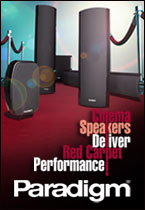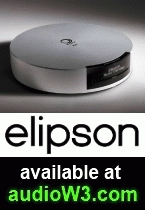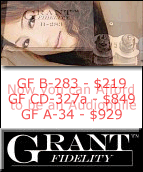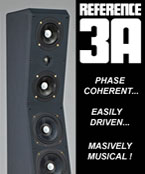
Now that the wintery weather is behind us, it’s time to get outside. And like many Canadians this summer, you’ll probably be soaking in the sun on your patio in the city or at the cottage. So why not make your time outdoors even more enjoyable with some tunes?
Listening to music outside can be as simple as using a boombox or an iPod speaker system. But if you prefer a higher quality of sound, you’ll want to install some good quality outdoor speakers. Not only will you be rewarded with a better sound, you also won’t have to bring equipment in and out of the house.
When done properly an outdoor speaker setup can be tastefully attractive and sound very good. Done poorly, it can sound tinny, muddy, and look tacky.
The Sonic Challenge of Outdoors
Any musician who has ever played an outside show knows one thing for sure: outside sucks up volume like nothing else. You’re not in your living room anymore, Dorothy, so don’t expect sound to bounce off walls and come rocketing back at you. It’s going to go out and not come back.
Acoustic technology has come a long way, but all things being equal, small speakers generally will not sound as good as a larger set that can move more air. Now before you set your flamethrower on “disintegrate”, I said, “generally”. There are always exceptions that make a rule, and indoors there are small speaker cabinets that completely blow away larger ones. However, small, unobtrusive speakers mounted outside don’t really stand a chance. Try to maximize bass response with strategic speaker placement.
Choosing Outdoor Speakers
Outdoor speakers are available in all sorts of shapes and sizes. The most common type is a bookshelf-style speaker, designed to be wall mounted. But if you’d like to conceal the speakers in your garden you may want to consider a “camouflage” speaker that has a cylinder shape, a rock shape or is built into a flowerpot. I’ve even seen frog-shaped outdoor speakers. Wireless outdoor speakers also exist. They are labeled as “wireless” because they don’t require you to run a speaker wire from the audio source to the speakers. However they do require power, which is usually provided by a rechargeable battery. A wireless outdoor speaker is nice in theory but not very practical for most applications.
Regardless of what shape or type of speaker you decide to go with, all outdoor speakers share one thing in common – they are all weather resistant and usually designed for both cold and warm climates. This means that you can leave them outdoors all year round. Although in order to prolong their life, it’s a good idea to bring them indoors during the winter.
Outdoor speaker enclosures are usually made out of a composite plastic-like material or powder-coated metal. Better quality enclosures are not only weather resistant, they are also UV resistant which means that the finish and colour of the enclosure should not be damaged by the sun. All bookshelf-style outdoor speakers are supplied with wall mounting brackets which allow the speakers to be aimed toward the listening position.
Most well-known speaker manufacturers offer a few bookshelf-style outdoor speaker models. These include brands such as Axiom Audio, Paradigm, JBL, Infinity, Klipsch, Polk Audio, Yamaha and Bose, just to mention a few. For a full list, check out the info box at the end of this article. Prices for these speakers start at about $150 and can reach all the way to several hundred dollars.
“Camouflage” speakers offer the advantage of blending in with the décor of your patio or the garden and come in various shapes, sizes and colours. The perimeter of a swimming pool is another great spot for these types of outdoor speakers.
One of the better known companies in this product category is SpeakerCraft. In addition to its bookshelf-style speakers, the company offers a number of rock-shaped speakers including three models with 5, 6 and 8-inch woofers (and 1/2-inch tweeter), a dual tweeter model and even a powered 8-inch subwoofer. All of these speakers have a realistic rock look and lack any noticeable grill holes.
TIC Corporation offers many various shapes of rock speakers in a number of different colours. The company’s Omni series consists of green cylinder-shaped speakers which project sound 360 degrees outside the enclosure. All models combine a woofer and a tweeter, while some models also have LED lights built-in which provide a gentle 360 degree light. A matching powered 8-inch subwoofer is also available. TIC also offers a pair of wireless rock speakers, powered by batteries, which come with a remote control.
StereoStone offers an impressively large selection of rock speakers and subwoofers in various shapes, sizes and colours. In addition to the rock designs StereoStone also makes a round planter speaker (which disperses sound in a 360 degree field), a rectangular planter speaker and two models of fountain speakers. To fill in the bottom frequencies the company offers a number of rock shaped subwoofers as well as subwoofers in the shapes of a planter and a tree stump. And to top it all off, StereoStone offers a selection of stereo rock speakers, which have dual woofers, designed to reproduce a wide stereo sound field.
If you have a swimming pool in your backyard and want the ultimate sound experience while swimming, you may want to consider an underwater speaker. A quick search on Google will lead you to a number of manufacturers.
Connecting Outdoor Speakers
The wire you choose should be appropriate for the purpose. It should be tough enough for external use, smooth enough to be pulled through walls, and capable of delivering a quality signal. Avoid bare wire connections when possible. Use proper connectors, like pins, plugs, or spades.
Assuming that your amplifier and source are indoors, run speaker wires to the outside through walls, not through doors and windows. It looks neater, and avoids the possibility of breakage from being constantly crimped in a door. The point where the wire exits the house should be as close as possible to the speaker location. Measure the distances you need for speaker cables a few times, and add at least five feet more. You can always cut off the excess, but a splice in a wire cut too short can reduce sound quality. Use the smallest drill bit you can get away with that still allows a wire to be pulled through easily. Use outdoor silicone sealant to fill the holes after the wire has been pulled through.
When using rock speakers placed in the garden, it is best to run the speaker wires underground. To do this, dig a narrow 12-inch deep trench and place the wires inside a plastic PVC pipe. This will prevent critters from biting through the wires and damage from a garden shovel.
Mounting and Positioning Outdoor Speakers
Bookshelf-type outdoor speakers come supplied with wall mounting brackets. Good quality brackets should have a solid feel and allow the speaker to be tilted in any desired direction. Use proper wood or masonry screws when attaching to brackets to a wall. If mounting into siding, be it wood, vinyl, or aluminum, make sure to use screws that are long enough to grab into the wood behind the siding.
The same goes for mounting on sofitt and fascia. It would be very embarrassing and expensive if your outdoor home improvement pulled down some of your house covering. And good siding installers are tough to find during the summer when they’re busiest.
Take advantage of walls and corners to boost bass frequencies. Generally, the higher the speakers are positioned, the further sound will travel out of them. Mounting the speakers under a roof or an awning will extend their life, as it will provide them protection from direct exposure to both rain and sun.
Powering and Controlling Outdoor Speakers
Most outdoor speakers are passive (non amplified) and hence you will need an amplifier to power them. The two most popular ways to power outdoor speakers are to use a separate integrated amplifier or the second zone output of an AV receiver. Many modern receivers offer a powered second zone output. Less expensive AV receivers offer a non-powered second zone output in which case you’ll have to hook up an additional amplifier. Using the second zone output of an AV receiver means that you can enjoy one source on your outdoor speakers (say a CD player) while someone indoors is listening to the radio or even watching a movie with surround sound.
If you’d like to have the ability to control the volume level and change music sources while outdoors, you’ll have to install an infra red (IR) repeater outside. Most AV receivers which offer a second zone output also come supplied with a second zone IR remote. A pricier solution is to use a radio frequency (RF) remote which doesn’t require an IR repeater. Keep in mind that since IR technology uses light, IR doesn’t may not work all that well in sunlight.
If you want to add sophistication and flexibility to your outdoor system, consider installing volume/source selection keypads. Of course taking this route adds cost to the system and means that you’ll have to run additional cables to the keypads (which usually use the same type of cable as computer networks).
Don’t rush with the installation of outdoor speakers and associated components. Plan your outdoor listening space properly. Consider where you spend most of your time on the deck or in the garden and position the speakers accordingly. Ask yourself where it would be most convenient to point the remote when adjusting the volume or changing sources. A well planned system will be a pleasure to use and provide you with hours of music enjoyment outdoors.
If you’re not comfortable with planning and installing an outdoor music system by yourself, consider hiring a qualified audio installer - most audio video stores offer such a service.
Links to Outdoor Speaker Manufacturers
Athena Technologies
Audiovox (Acoustic Research, Jensen)
Axiom Audio
Bose
Boston Acoustics
Energy Loudspeakers
Infinity
Jamo
JBL
KLH Audio Systems
Klipsch
Mirage
Monitor Audio
NHT Loudspeakers
Niles Audio
OWI Inc.
Paradigm
Phase Technology
Polk Audio
Rockustics
Sonance
SpeakerCraft
The Speaker Company
Stereostone
Tannoy
TruAudio Architectural Loudspeakers
Wharfedale
Yamaha
Click here to discuss this article on the CANADA HiFi Forum















